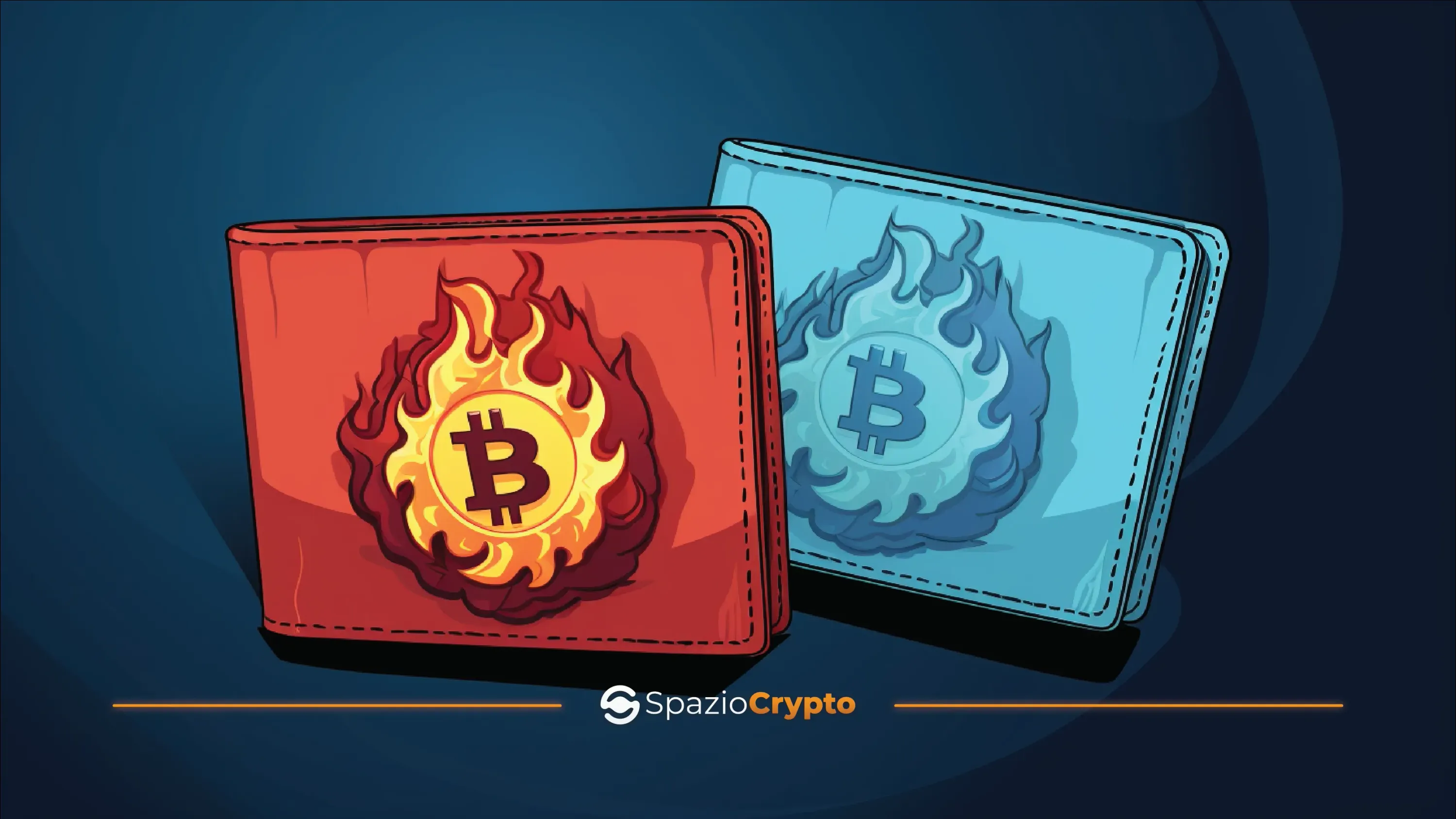Through decentralisation and cryptography, cryptocurrencies have opened up new possibilities, allowing individuals to have unprecedented control over their digital assets. However, with this innovation comes significant challenges, especially in terms of security. In this Spaziocrypto article, we will explore the crucial importance of security in cryptocurrencies and how the choice between hot wallet and cold wallet is key to protecting digital investments.
Security in Cryptocurrencies Hot vs Cold Wallet
The cryptocurrencies, in particular the pioneering Bitcoin, have introduced a new paradigm in the financial sphere, breaking down barriers and offering an alternative vision of how transactions and wealth management could evolve. However, this decentralisation and the digital nature of cryptocurrencies make them susceptible to various threats, requiring a new awareness and intelligent approach to security.
Security as a Fundamental Priority
If you own cryptocurrencies, you understand that security is a key element in the context of this financial revolution. Vulnerability to cyberattacks, the risks associated with private keys and the increasing complexity of threats make it essential to adopt a prudent and well thought-out strategy to protect your digital investments.
Hot Wallets: Quick Access, But At What Cost?
Hot wallets, similar to the traditional wallets you carry with you, offer instant and convenient access to your cryptocurrencies. They are easily accessible online, allowing instant transactions and flexibility. However, this convenience comes with increased exposure to cyber risks. We will explore in detail how hot wallets work, highlighting their advantages and the potential risks associated with this ease of use.
Cold Wallet: Security First
Cold wallets, on the other hand, represent a solution designed with the primary objective of ensuring maximum security. By keeping private keys offline, cold wallets significantly reduce the risk of unauthorised access and online attacks. This option is particularly suitable for those who aim to store their cryptocurrencies for the long term. We will look at the various types of cold wallets and why they may be the wisest choice for robust, long-term protection of your funds.
A Journey into Hot and Cold Wallet Comparison
In this journey of exploration between hot and cold wallets, we will delve into the nuances of both options. The goal is to equip you with the information you need to make informed decisions about the security of your cryptocurrency investments. Through an in-depth understanding of the features, benefits and risks associated with each type of wallet, you will be able to shape a digital asset management strategy that is perfectly suited to your needs.
Hot Wallets: The Practical Side
Hot wallets emerge as a practical and straightforward solution for managing your digital assets. These online wallets offer unparalleled ease of use, allowing instant transactions and unhindered access to your funds. However, like any convenience, it brings with it a number of considerations and risks that it is crucial to understand.
The Dynamics of Hot Wallets
Hot wallets are accessed through Internet-connected devices, such as computers, smartphones or tablets. Their 'hot' nature comes from the constant connection to the network, allowing users to quickly access their funds to perform transactions anytime, anywhere. This speed is a strength, but also their inherent vulnerability.
Hot Wallet Advantages
- Instant Access: The main attraction of hot wallets is the ability to instantly access your funds. This makes them ideal for those who make regular transactions and need flexibility in managing cryptocurrencies.
- Convenience: Hot wallets are often praised for their intuitive user interface and simplified user experience. They are designed to be user-friendly, making them accessible even to those who are new to the world of cryptocurrencies.
- Integration with Online Services: Many hot wallets are integrated with online services such as exchanges, further simplifying the process of trading and exchanging cryptocurrencies.
Risks Associated with Hot Wallets
- Exposure to Cyber Risks: Being constantly connected to the network, hot wallets are more susceptible to cyberattacks. Hackers can exploit vulnerabilities in software or use phishing techniques to gain unauthorised access to funds.
- Possibility of Total Loss: In the event of a security compromise, hot wallets can be subject to significant financial losses. Speed of access can become a risk when appropriate security measures are not taken.
- Dependence on Internet Connectivity: The functionality of hot wallets is dependent on the Internet connection. In situations where connectivity is limited or absent, access to funds may be compromised.
Security Strategies for Hot Wallets
- Two-Factor Authentication (2FA): Implementing two-factor authentication can significantly increase the security of hot wallets by requiring an additional verification step beyond a simple password.
- Regular Software Updates: Keeping hot wallet software up-to-date is essential to ensure the latest security patches are installed.
- Limited Use for Significant Amounts: Reserve the use of hot wallets for small amounts of cryptocurrencies, keeping significant amounts in more secure wallets such as cold wallets.
In the next chapter, we will explore the world of cold wallets, delving into their features and analysing how they can offer a more robust solution in terms of security for your cryptocurrencies in the long term.
Protect Your Investments With Cold Wallets
In an effort to provide maximum security for cryptocurrencies, cold wallets are emerging as a secure and reliable alternative to hot wallets. These offline wallets offer a number of advantages that make them ideal for those seeking to preserve their digital assets for the long term, while minimising the risks of exposure to cyber threats.
The Cold Wallet Philosophy
Unlike hot wallets, cold wallets keep their keys private offline, thus drastically reducing their exposure to potential online attacks. This crucial aspect makes them particularly suitable for those looking for a secure, long-term storage solution for their cryptocurrencies.
Cold Wallet Types
- Hardware Wallets: These are physical devices designed solely for storing private keys and authorising transactions. Being isolated from online connections, hardware wallets offer a high level of security.
- Paper Wallet: A paper wallet essentially consists of a physical printout containing private and public keys. It is a completely offline way of storing cryptocurrencies, but requires care to avoid physical damage or loss.
Cold Wallet Advantages
- Maximum Security: The main attraction of cold wallets is their advanced security. Being offline, they are virtually immune to the cyberattacks that threaten hot wallets.
- Long-Term Storage: Cold wallets are ideal for those wishing to store cryptocurrencies for the long term. Their offline design protects them from many of the threats associated with short-term hot wallet management.
- Virus and Malware Protection: Hot wallets can be susceptible to viruses and malware, whereas cold wallets, being offline, are immune to such threats.
Critical Considerations
- Inconvenient for Frequent Transactions: Unlike hot wallets, cold wallets may not be the most practical choice for those who make regular transactions. Quick access and flexibility are sacrificed in favour of security. They are not suitable for doing cryptocurrency trading.
- Care in Storage: Cold wallets require special care to avoid physical damage or loss.
Choosing the Right Balance
Choosing between hot and cold wallets is not necessarily a matter of "either/or", but rather of finding the right balance according to your needs. In the next chapter, we will explore the main cyberthreats and preventive measures, providing you with a comprehensive view on how to best protect your cryptocurrency investments.
How to Protect Your Crypto Funds
In cryptocurrencies, security is a crucial aspect of preserving your digital funds. Various cyber threats threaten the security of your cryptocurrencies, requiring in-depth understanding and effective prevention measures. We will explore the main cyber threats and strategies to protect your digital investments.
Main Cyber Threats
- Phishing: Phishing attacks involve fraud through deception, often through fake emails or websites that aim to steal your credentials. Their sophistication can make them difficult to recognise.
- Malware
- : Viruses and malicious software can compromise the security of hot wallets, particularly when they are Internet-connected devices. Malware such as keyloggers can record your actions and compromise private keys.
- DDoS Attacks: Distributed Denial of Service (DDoS) attacks can overload a network, preventing access to cryptocurrency services and causing financial losses for users.
- Attacks on Private Keys
- : Hackers can try to gain access to private keys, which are essential for managing and accessing funds. Once compromised, all digital assets can be at risk.
Prevention Measures
- Education and Awareness: Keeping yourself informed of the latest security threats and practices is critical. Education is the first step to recognising and avoiding phishing attacks and other scams.
- Using Firewall and Antivirus Software: Maintaining good antivirus software and an active firewall can significantly reduce the risk of malware and cyber attacks.
- Two-Factor Authentication and Confirmation (2FA): Enabling 2FA can add an extra layer of security by requiring additional verification beyond a password for access.
- Multi-Signature Wallets: Multi-Signature Wallets require more than one private key to authorise a transaction, offering greater security against unauthorised access.
- Secure Backups: Performing regular backups of your private keys and storing them in secure locations can protect your funds in the event of device loss or damage.
Combined Use of Hot and Cold Wallets
An effective strategy can also involve synchronising between hot and cold wallets. Keeping a limited amount of cryptocurrencies in hot wallets for daily transactions, with the majority of funds stored in cold wallets, can be a balanced compromise between security and accessibility. Taking care of cryptocurrency security requires long-term planning. Constantly monitoring emerging threats, taking proactive preventive measures, and remaining flexible in improving your security practices are essential elements to successfully protect your digital investments.
Wise Choice: Hot, Cold or Both?
With a thorough understanding of hot and cold wallet dynamics, it is time to examine how to optimise cryptocurrency security through a balanced strategy. The choice between hot, cold or a combination of both should reflect your needs, financial management style and desired level of security.
Key Considerations
- Frequency of Transactions: If you make frequent transactions, a hot wallet can offer you the flexibility you need. However, limit the amount stored in these virtual pockets and consider a cold wallet for long-term assets.
- Importance of Investments: Significant amounts should be kept in a cold wallet. This minimises the risk of unauthorised access and protects digital assets from online threats.
- Quick Access vs. Security: Balance the need for quick access with the importance of security. For example, you might use a hot wallet for day-to-day transactions, but keep most of your funds in a cold wallet.
- Diversification: Consider diversification across different types of wallets. For example, you might have a hardware wallet for maximum security, a hot wallet for flexibility.
Strategies of Use
- Daily Transactions: Use a hot wallet to handle everyday transactions, facilitating the access and flexibility needed for routine financial activities.
- Long-Term Storage
- : Invest in a cold wallet for assets you do not plan to use frequently. Hardware wallets are particularly suitable for this purpose.
- Secure Backups: Regardless of the type of wallet you use, make sure you have secure backups of your private keys. This can mitigate the risk of loss in the event of device damage or loss.
Further Considerations
- Updates and Ongoing Security: Keep your wallets up-to-date and adopt the latest security practices. The world of cryptocurrency is constantly evolving, and security requires constant effort.
- Activity Monitoring: Regularly monitor your wallet's activities. Watch for any anomalies that could indicate unauthorised access and act promptly if suspected.
- Expert Advice: If necessary, seek advice from cybersecurity and cryptocurrency experts. Specialists can offer advice tailored to your specific needs.
Your Personal Strategy
Choosing between hot, cold or a combination of both is a highly individual process. At Spaziocrypto, we would like to recommend that your strategy should fit your financial needs, the level of risk you are willing to take, and your appetite for advanced technology.
After exploring the vast universe of cryptocurrencies, wallet security and management strategies, it is now time to summarise the main conclusions for keeping your digital investments safe.
Summary of Portfolio Choices
- Hot Wallet: Ideal for everyday transactions and quick access. Limit the amount stored to reduce the risk of exposure to online threats.
- Cold Wallet: The safest choice for long-term storage. Use cold wallets, like hardware wallets, to protect your investments from cyberattacks.
- Combine Hot and Cold: Balance your need for quick access with security using a combination of hot and cold wallets. Keep most of your funds in the cold wallet and a small amount in the hot wallets for flexibility.
.








